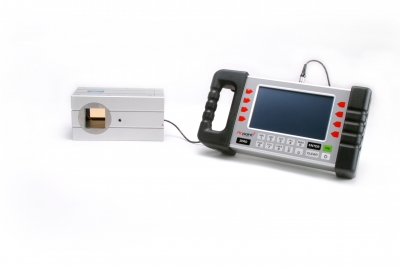
Pinpoint Laser Systems announces the release of its latest laser alignment accessory, the 2-Inch Transparent Receiver, for receiving laser signals to achieve machinery and equipment alignment.
The 2-Inch Transparent Receiver differs from Pinpoint’s existing Transparent Receiver in that it is significantly larger than the original. While the original receiver window measures ¾”x¾”, the 2-Inch Transparent Receiver window measures 2”x2”, allowing for a wider range of measurements down to 0.0001 inch and over distances of 150 feet or more. As with the original Transparent Receiver, it is also manufactured with solid aluminum housing and reference surfaces and mounting points for a number of industrial applications.
Pinpoint’s 2-Inch Transparent Receiver works by allowing the incoming laser reference beam to pass cleanly through to other receivers while making a precise pair of linear measurements. The position of this receiver is measured in real time to the centerline of the laser beam for precise measurements of machine tool motion and other industrial applications.
The 2-Inch Transparent Receiver is Pinpoint’s latest innovation for engineers and machine operators to achieve lathe and spindle alignment, machine tool runout, roll and web alignment, precision bore alignment, among other industrial applications. This product is available as is or can be customized to meet a manufacturer’s exact specifications if needed.
Contact Details
Related Glossary Terms
- lathe
lathe
Turning machine capable of sawing, milling, grinding, gear-cutting, drilling, reaming, boring, threading, facing, chamfering, grooving, knurling, spinning, parting, necking, taper-cutting, and cam- and eccentric-cutting, as well as step- and straight-turning. Comes in a variety of forms, ranging from manual to semiautomatic to fully automatic, with major types being engine lathes, turning and contouring lathes, turret lathes and numerical-control lathes. The engine lathe consists of a headstock and spindle, tailstock, bed, carriage (complete with apron) and cross slides. Features include gear- (speed) and feed-selector levers, toolpost, compound rest, lead screw and reversing lead screw, threading dial and rapid-traverse lever. Special lathe types include through-the-spindle, camshaft and crankshaft, brake drum and rotor, spinning and gun-barrel machines. Toolroom and bench lathes are used for precision work; the former for tool-and-die work and similar tasks, the latter for small workpieces (instruments, watches), normally without a power feed. Models are typically designated according to their “swing,” or the largest-diameter workpiece that can be rotated; bed length, or the distance between centers; and horsepower generated. See turning machine.
- web
web
On a rotating tool, the portion of the tool body that joins the lands. Web is thicker at the shank end, relative to the point end, providing maximum torsional strength.








